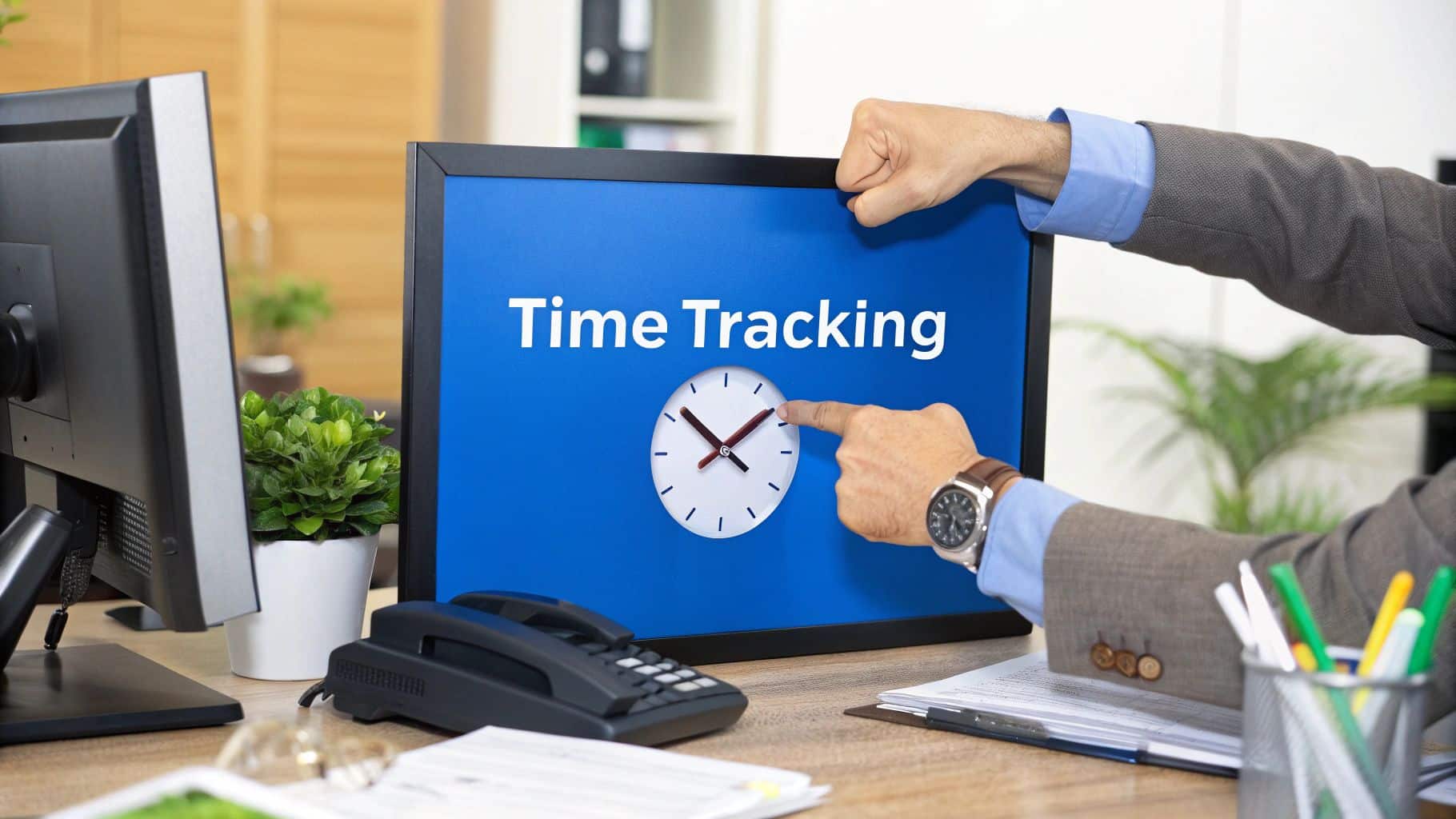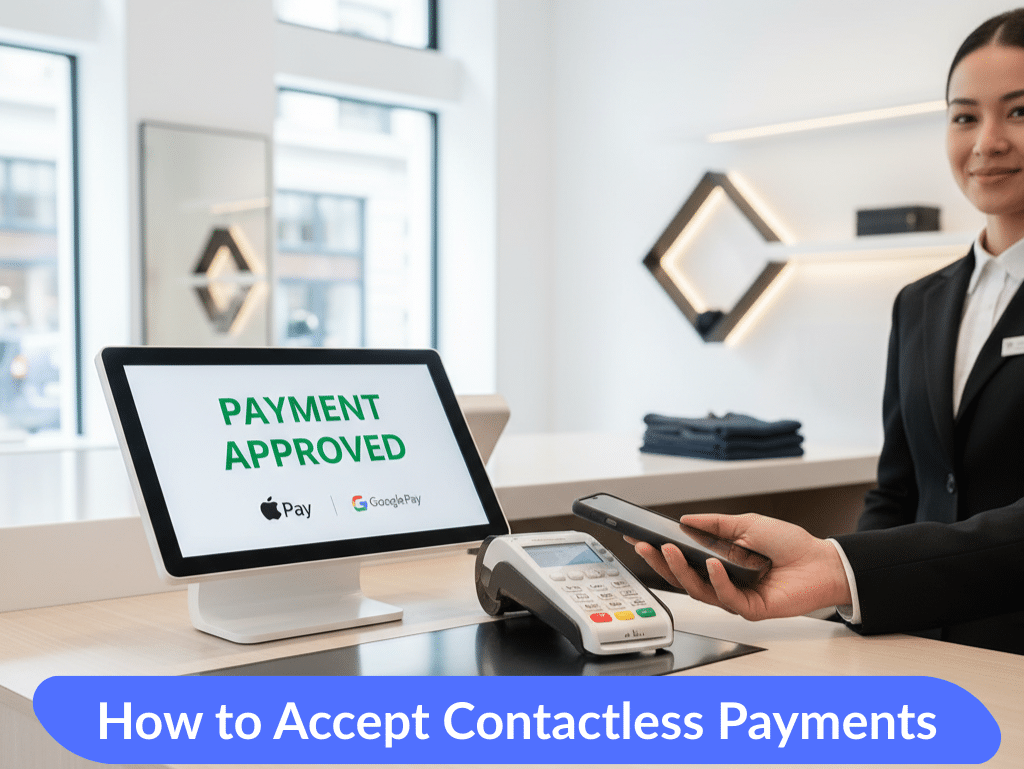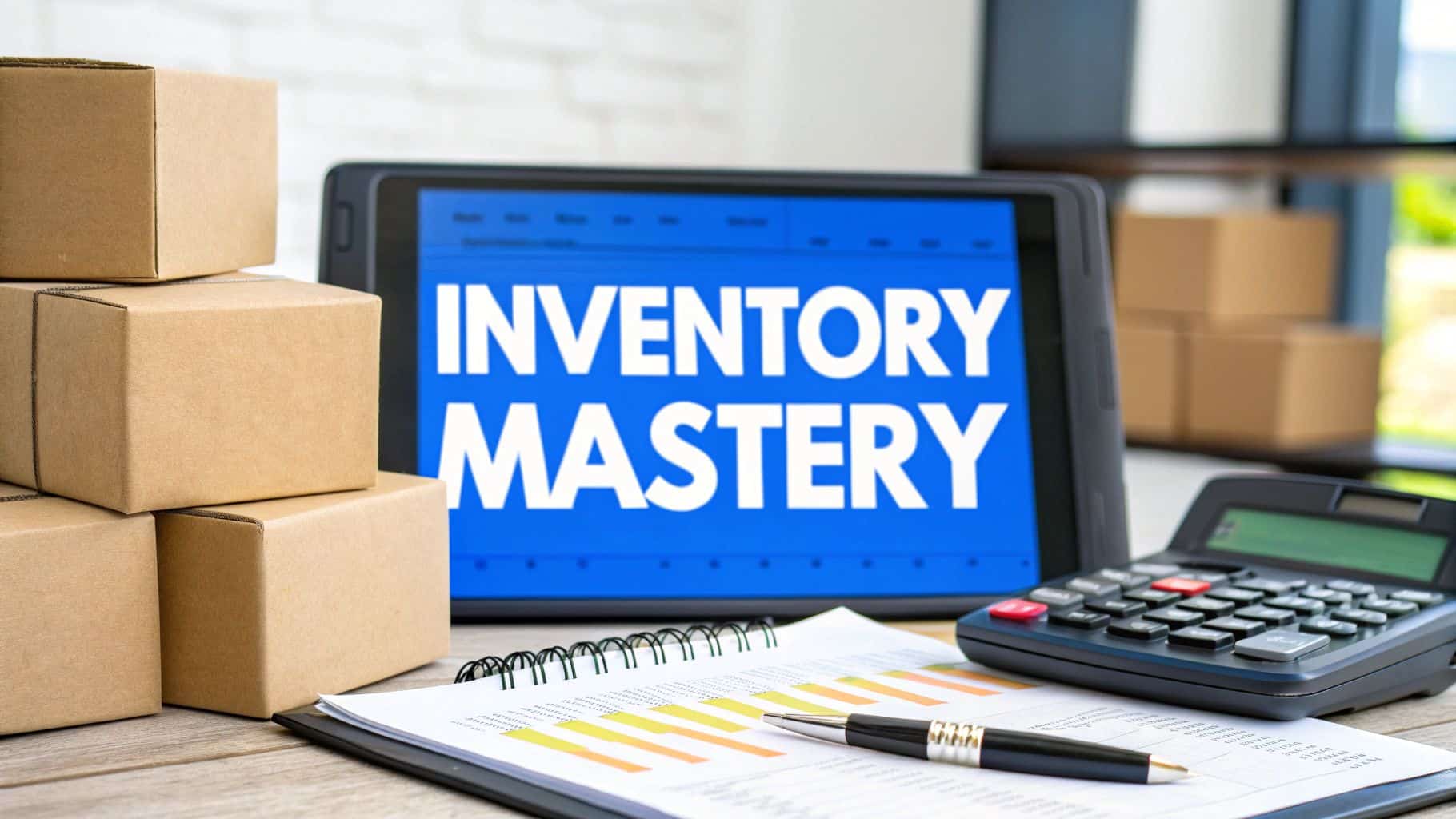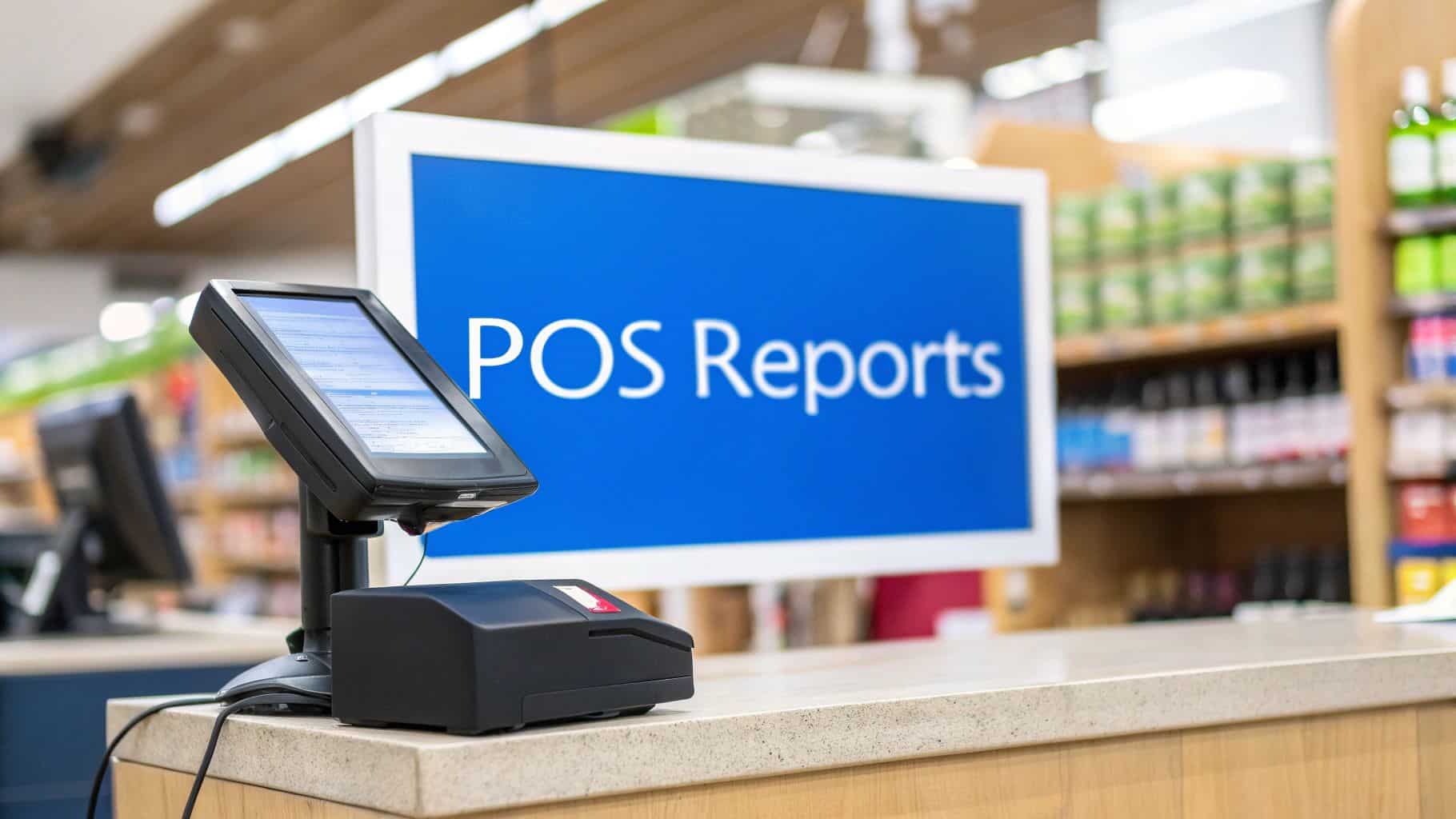When you're searching for the best POS system for a small restaurant, you're looking for more than just a payment processor. You need a partner that understands the chaos of a busy service. Industry leaders have built their platforms around the specific needs of restaurants, covering everything from managing orders and tracking inventory to building customer loyalty.
Why a Modern POS Is Your Restaurant's Command Center

Picture the Saturday night dinner rush. Orders are flying, tables need turning, and the kitchen is a whirlwind of activity. In that high-pressure environment, an old-school cash register is a liability. It just can't keep up. This is where a modern Point of Sale (POS) system steps in, acting less like a transaction tool and more like the central nervous system of your entire operation.
Think of it as your operational co-pilot, not just a digital cash drawer. It connects every part of your restaurant, from the host stand to the kitchen line and back to the front-of-house staff. For a small restaurant, this isn't just a nice-to-have feature; it’s the foundation for staying competitive and growing your business.
More Than Just a Transaction Tool
A modern POS is a smart investment that ties all the loose ends of your business together. Instead of juggling separate systems for different tasks, everything works in harmony. For a small restaurant, the benefits are immediate and substantial.
- Run a Tighter Ship: Imagine orders zinging directly to the kitchen display screen the moment they're taken. Your POS can do that, while also keeping a running count of your inventory and managing your table statuses. This cuts down on human error and frees up precious time.
- Give Customers a Better Experience: Your staff can take orders right at the table, split checks without a headache, and take payment on the spot. It looks professional and feels seamless to your guests, which keeps them coming back.
- Make Smarter Decisions: The system gathers a goldmine of data for you. You can instantly see which dishes are best-sellers, spot sales trends, and figure out the busiest times of day. This information helps you make better calls on everything from menu engineering to staff scheduling.
A great POS connects every way a customer interacts with you, giving you a complete picture of your business and helping you deliver a consistent what is omnichannel customer experience.
For a small restaurant, every tiny bit of efficiency goes straight to the bottom line. A POS system isn't just about taking money; it's about fine-tuning your entire workflow to serve more happy customers, waste less, and boost your profits.
Let's take a quick look at why a modern system is such a game-changer compared to older methods.
Quick Look Why a Modern POS Is Essential
| Benefit | Impact on Your Small Restaurant |
|---|---|
| Operational Speed | Faster order-taking and payment processing means quicker table turnover and more customers served. |
| Real-Time Data | Instantly see sales reports, inventory levels, and staff performance to make informed decisions on the fly. |
| Reduced Errors | Digital order entry eliminates messy handwriting mistakes, reducing food waste and incorrect charges. |
| Enhanced Service | Features like tableside ordering and easy check-splitting create a smoother, more professional guest experience. |
| Business Integration | Connects to accounting software, loyalty programs, and online ordering, creating a unified tech ecosystem. |
This shift from simple cash registers to integrated command centers is why the industry is growing so fast. The global restaurant POS systems market is expected to grow at a compound annual rate of about 6.44% between 2025 and 2035. This growth is all about restaurants like yours demanding smarter, cloud-based tools that do more than just ring up sales.
Getting to Grips with the Core POS Features You'll Actually Use
When you start shopping for the best POS system for a small restaurant, it’s easy to get overwhelmed. The feature lists can seem endless, and every salesperson promises their gadget will solve all your problems. Let's cut through the noise.
Instead of getting bogged down by every single bell and whistle, we're going to focus on the non-negotiable functions that truly matter for your daily grind. Think of these as the foundation of your restaurant’s command center—the tools that turn a chaotic dinner rush into a smooth, controlled service.
Seamless Order and Table Management
At its most basic, a POS has to be brilliant at taking orders. This isn’t just about punching in a burger and fries anymore. A modern system should let your servers take orders right at the table using a tablet. It looks sharp, but more importantly, it speeds everything up and drastically cuts down on mistakes from scribbled, hard-to-read notes.
Once that order is in, it needs to fly directly to the right prep station—the grill gets the steaks, the bar gets the cocktails. This instant communication is what keeps a kitchen running like a well-oiled machine, even when every table is full. You'll also want a system with a clear, visual floor plan that lets you see which tables are open, occupied, or waiting for the check at a single glance.
Flexible and Fast Payment Processing
Getting paid should be the easiest part of the meal. Your POS must handle all the ways people pay today without skipping a beat, from traditional credit cards to tap-to-pay and mobile wallets. Given that 54% of all POS transactions are now contactless, this isn't a "nice-to-have"—it's a must.
The real test? When a table of eight wants to split the bill eight different ways, some paying cash and some with cards. A great POS handles this nightmare scenario in seconds, letting your staff split checks by item or by person with just a few taps. It’s a small detail that makes a massive difference in customer happiness and table turnover.
Practical Inventory and Menu Management
Think of your POS as a smart pantry that always knows exactly what’s on the shelf. Instead of doing tedious manual counts every night, the system should automatically deduct ingredients from your stock as you sell dishes. This is a complete game-changer for managing food costs.
- Low-Stock Alerts: Get a heads-up when you’re about to run out of avocados for your famous guacamole, preventing the dreaded moment you have to 86 a bestseller mid-service.
- Easy Menu Updates: Need to add a daily special or mark the fish as sold out? You should be able to make that change once and have it instantly update across every single terminal and tablet.
Actionable Reporting and Analytics
A truly great POS doesn't just process sales; it gives you the story behind the numbers. And you shouldn't need a PhD in statistics to figure it out. The reports should be simple, visual, and tell you what you need to know to run a smarter business.
This means you can quickly see which dishes are your rockstars and which ones are duds. You can track sales trends to know when you’re busiest and monitor server performance to reward your top staff. These insights are pure gold, helping you make better decisions on everything from menu engineering to staffing schedules.
2. Choosing Your POS Type: Cloud vs. On-Premise
One of the very first big decisions you'll make when picking a POS system is whether to go with a cloud-based or an on-premise setup. It’s a foundational choice that shapes everything from your daily workflow to your budget.
Think of an on-premise system as having a big, dedicated computer server humming away in your back office. You own it outright. That means you have complete control over it, but it also means you're the one on the hook for all the maintenance, security, and software updates. It's a hefty upfront investment in hardware that lives and breathes within your restaurant.
A cloud-based system, on the other hand, is a lot more like your Netflix subscription. All your critical data—sales, reports, inventory—isn't stored on a machine you have to worry about. Instead, it’s kept safe and sound online. This is a game-changer because you can check in on your restaurant from anywhere, whether you're at home doing payroll or on a much-needed vacation.
The Modern Choice: Cloud-Based Systems
It's no surprise that most modern POS systems are cloud-based. They just make sense for today's restaurant environment. They typically run on a Software-as-a-Service (SaaS) model, which simply means you pay a predictable monthly fee instead of dropping a huge sum of money all at once. This makes top-tier technology affordable for small businesses.
This model is also incredibly flexible. Because the software usually runs on everyday devices like an iPad, you can easily implement tableside ordering or add another payment station during a busy season without buying expensive, proprietary hardware. If you want to dive deeper, you can learn more about what a cloud-based POS system is and how it can directly impact your operations.
The Old Guard: On-Premise Systems
On-premise systems, often called legacy systems, keep all your data stored locally on a closed network inside your restaurant. Their biggest selling point? If your internet goes down, you can still ring up sales because everything is processed internally.
But that reliability comes with some serious strings attached. You become the IT department. You're responsible for backing up your own data, protecting the system from viruses, and paying for expensive software upgrades. And if that server in the back office dies? The cost and headache of fixing or replacing it fall squarely on your shoulders.
To make the differences crystal clear, let's break it down side-by-side.
Cloud POS vs. On-Premise POS: A Head-to-Head Comparison
| Feature | Cloud-Based POS | On-Premise POS |
|---|---|---|
| Initial Cost | Low (monthly subscription) | High (lump-sum hardware & software purchase) |
| Data Access | Accessible from anywhere with an internet connection | Only accessible from within the restaurant's network |
| Updates | Automatic and included in the subscription | Manual, often costly, and require downtime |
| Maintenance | Handled by the provider | Your responsibility (or you pay an IT pro) |
| Security | Managed by the provider with expert teams | Your responsibility to set up and maintain |
| Offline Mode | Most modern systems have robust offline capabilities | Fully functional without internet |
| Scalability | Easy to add new terminals or locations | Difficult and expensive to expand |
Ultimately, choosing between the two depends on your budget, your comfort level with technology, and where you see your restaurant going in the future.
While on-premise offers a sense of total control, the cloud delivers the flexibility, affordability, and peace of mind that most growing restaurants need to thrive.
Take a look at this chart. It lays out how some of the most popular POS systems stack up against each other based on real-world factors like cost, user-friendliness, and how well they play with other software.
This kind of visual comparison really helps you see, at a glance, which systems offer the best bang for your buck by balancing monthly fees with actual user ratings and the ability to connect with other tools you use.
Once you’ve nailed down the essentials, the right POS system stops being just a cash register and starts becoming your partner in growth. Think of it as the brain of your restaurant operation. These advanced features are what really separate the good systems from the great ones—the ones that don't just process transactions, but actively help you build a smarter, more profitable business.
This is where the magic happens. Your POS shifts from just taking orders to giving you the insights and tools you need to build customer loyalty, fine-tune your menu, and run a tighter ship.
Building a Community with Customer Relationship Management
A great restaurant isn't just about food; it's about making people feel welcome. A modern POS with Customer Relationship Management (CRM) features helps you do just that. It’s like having a digital notebook that remembers every regular's name, their favorite table, and what they ordered last time.
With this information at your fingertips, you can build a genuine connection. You can create loyalty programs that actually reward your best customers or send out a special birthday offer. It’s these small, personal touches that make people feel seen and turn a one-time guest into a die-hard fan.
Unlocking Smarter Decisions with Advanced Analytics
Basic sales reports tell you what you sold. Advanced analytics tell you why you sold it and what you should do next. This is where you move from just counting your daily earnings to truly understanding the pulse of your restaurant.
One of the most powerful things you can do with this data is menu engineering. This is the art of analyzing every dish based on its popularity and profitability. You’ll quickly see which items are your cash cows and which are duds, helping you design a menu that maximizes every single order.
These insights also take the guesswork out of staffing. By tracking customer traffic patterns hour-by-hour, you can build schedules that match your real needs. No more being short-staffed during a surprise dinner rush or paying a full crew to stand around on a slow Monday. This also ties into how you manage customer flow, and things like the benefits of self-ordering kiosks in restaurants can help you handle those peak times even more efficiently.
Creating a Connected Operation with Integrations
Your restaurant relies on more than just a POS. You have accounting software, online ordering platforms, and marketing tools. A POS with strong integration capabilities acts as the central hub, making sure all these different systems talk to each other.
A well-integrated system can make a world of difference.
- Online Ordering Platforms: Orders placed on your website or through apps like DoorDash can appear directly in your kitchen display system, eliminating the need to manually punch them in.
- Accounting Software: Your daily sales can automatically sync with tools like QuickBooks, saving you or your accountant hours of tedious data entry.
- Marketing Tools: Customer information can flow right into your email marketing platform, making it easy to send out newsletters or special promotions.
When your technology works together, your entire operation becomes smoother and more efficient. It cuts down on human error, saves an incredible amount of time, and gives you a single, unified view of your business.
Finding the Right POS Provider
Picking out features is one thing, but choosing the right company to partner with is a whole different ball game. Don't think of it as just buying software; you're essentially hiring a technology partner for the long haul. This relationship will dictate the support you get, how clear your costs are, and whether your system can actually keep up as you grow.
It's easy to get wowed by a slick sales demo, but you have to dig deeper and ask the tough questions. A great provider offers more than just a cool interface—they give you a rock-solid foundation for your day-to-day grind. This is especially true when you're looking for the best POS system for a small restaurant, where every dollar and every minute is precious.
Can Your Staff Actually Use It?
Here’s the real litmus test: Can a brand-new server, on their very first shift, learn the system well enough to take orders and handle payments without a meltdown? If the system is clunky or overly complicated, it's going to drag down your service speed and frustrate everyone from the host stand to the kitchen.
When you get a demo, make them show you what it’s like in the weeds. Ask them to walk you through real-world, high-stress situations:
- A table of ten wants to split the check ten different ways. How messy is that?
- A customer has a complicated allergy and needs a custom order. How fast can a server punch that in?
- The kitchen just ran out of salmon. How quickly can you 86 it from the menu so no one else orders it?
A POS built by people who understand the frantic pace of a restaurant will make these core tasks feel second nature.
Customer Support Isn't a Luxury, It's a Lifeline
Picture this: It's 7:30 PM on a Saturday, the restaurant is packed, and your POS system goes down. This isn't just a minor hiccup; it's a catastrophe that could cost you hundreds in sales and tank your reputation. That’s precisely why 24/7 customer support from a real, live human is completely non-negotiable.
Before you even think about signing a contract, get the full story on their support. Who are you talking to when things go wrong—a person, or a chatbot? What’s their average wait time when you have a critical issue? The quality of a provider's support team is one of the most important parts of this decision.
Get Real About Pricing and Watch Out for Hidden Fees
POS pricing can feel intentionally confusing. You've got hardware costs, monthly software fees, and payment processing percentages all bundled together. A provider you can trust will be upfront about every single charge. Demand a detailed quote that breaks everything down, and if a company is cagey about their fee structure, walk away.
The market is competitive, but a few big players run the show. The top 10 POS companies are behind 84.24% of all installations in major US cities, with giants like NCR/ALOHA alone holding a 30.18% market share. This tells you that most restaurants tend to stick with established names known for reliability. You can dive deeper into these restaurant POS market share trends to see who the major players are. Your job is to find a provider who gives you a fair, transparent price that won't surprise you with hidden costs down the road.
Your POS Implementation and Staff Training Plan
Alright, so you've picked out the perfect POS system for your restaurant. That’s a huge step, but the job isn't done yet. The real make-or-break moment comes down to how you roll it out. A smooth, well-planned implementation will get your team excited and confident, while a chaotic one can throw a wrench into your entire operation.
Think of it as the dress rehearsal before opening night. You wouldn't open your doors without finalizing the menu or training the chefs, right? Same principle applies here. All the behind-the-scenes work—setting up the hardware, programming the menu—needs to be dialed in long before your staff starts taking orders on it.
Setting Up for Success
Before you even think about showing the system to your team, you need to build a solid foundation. This first phase is all about getting the technical side of things buttoned up and ready to go.
-
Hardware Installation: This sounds simple, but it’s crucial. Where you place your terminals, tablets, and printers matters. A kitchen printer that’s ten extra steps away or a payment terminal in an awkward spot can slow down service and create frustrating bottlenecks during a rush.
-
Menu and Floor Plan Programming: This is where you bring your restaurant to life inside the system. You’ll need to meticulously enter every single menu item, complete with all its modifiers, options, and prices. Don't forget to build out your digital floor plan to match your physical layout for seamless table management.
-
Data Migration: If you’re upgrading from an older system, you'll want to bring your valuable data with you. This means carefully migrating customer lists and loyalty program information so your regulars don't miss a beat.
Empowering Your Team with Effective Training
Your staff is the heart of your restaurant, and how well they use this new tool will directly affect the guest experience. If training is rushed or incomplete, you can expect mistakes, frustrated employees, and slower service.
A great POS system is intuitive, but great training is intentional. The goal is to make every team member—from servers to kitchen staff—feel like an expert before the system goes live during a dinner rush.
I've found that a phased approach to training works wonders. Start with your managers and lead servers first. This creates a group of in-house experts who can then help train the rest of the team and answer questions on the fly.
Invest the time here. There are some fantastic guides out there to help you structure your program. You can learn more about effective point of sale software training to make sure everyone is ready for launch day. When you put in the effort up front, your new POS will feel less like a new piece of tech and more like a powerful partner from day one.
Got Questions? We've Got Answers.
Choosing the right POS system feels like a huge decision—because it is. It's about finding a long-term partner for your restaurant. Let's tackle some of the most common questions that come up when you're trying to weigh cost, features, and where you want your business to go.
What's a Realistic Budget for a Small Restaurant POS?
Honestly, the price tag can be all over the map. It really depends on the hardware you need, the software plan you choose, and the payment processing fees that come with it.
For a small spot, you could be looking at anything from a few hundred dollars to a few thousand just to get the hardware set up. After that, expect a monthly software subscription somewhere in the $50 to $150 range for each terminal you have. My best advice? Always, always ask for a complete, itemized quote so you aren't blindsided by hidden fees later.
Can We Just Use an iPad for Our POS?
Absolutely! In fact, many of the best modern POS systems are built from the ground up to run on iPads and other tablets. This is a game-changer for small restaurants.
Using an iPad is a flexible and affordable way to skip the clunky, old-school terminals. They’re perfect for servers taking orders right at the table or for kitchens with tight counter space. You get all the power you need in a device that your team already knows how to use.
What's the Single Most Important Thing to Look For?
While a long list of fancy features is tempting, the two things that truly matter for a small restaurant are reliability and solid customer support.
Think about it: your POS is the central nervous system of your entire operation. If it crashes in the middle of a dinner rush, your business grinds to a halt. Before you sign anything, make sure the provider has a rock-solid reputation for uptime and offers responsive, helpful 24/7 support. You need to know someone will have your back when things go wrong.
Ready to see how an all-in-one POS can simplify your restaurant operations? Biyo POS offers a powerful, intuitive solution designed for businesses like yours. Start your 14-day free trial today!







